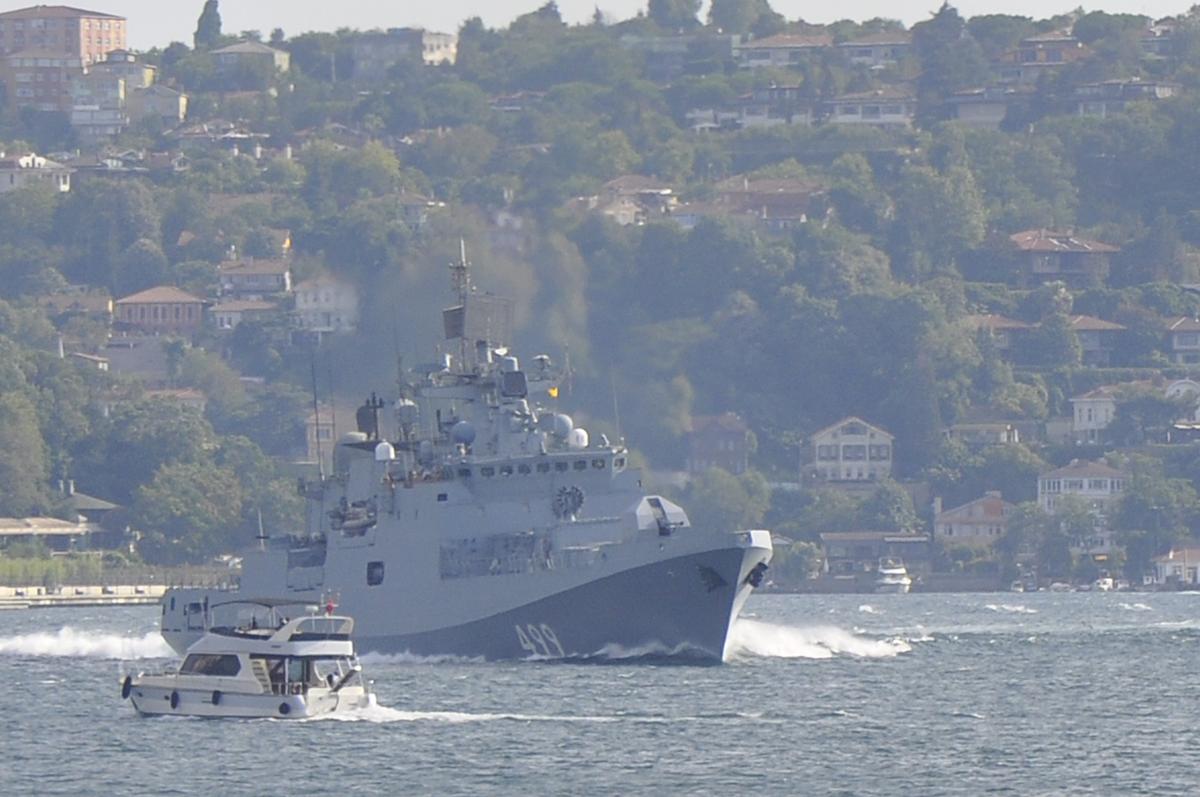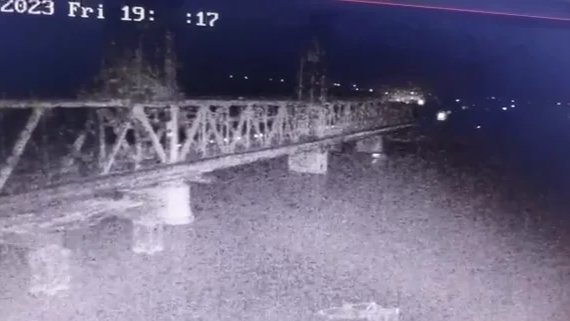The road of life
On 10 February, for the first time during the war in Ukraine, the Russian Armed Forces used a naval surface drone. Valery Zaluzhny, head of the Armed Forces of Ukraine, said on his Telegram channel that he had phoned General Mark Milley, the chairman of the Joint Chiefs of Staff of the United States, about this incident: “I shared my concern about Russia’s use of sea surface drones, which poses a threat to civilian navigation in the Black Sea,” the message says.
The day after the incident, a video of the bridge blowing up in the Odesa region appeared on Telegram channels. These shots show how a high-speed surface kamikaze drone struck a drawbridge over the Dniester Estuary in the village of Zatoka on the Budak Spit at the exit to the Black Sea. The reports said that the attack damaged the supports of the structure. It is obvious that the bridge requires serious repairs.
Footage of a bridge in the Odesa region being destroyed by Russian army naval drones.
As a result of the attack, the southern part of the Odesa region was completely cut off. From Ukraine, it is now possible to get there only through the highway passing via neighbouring Moldova. The Russians had attacked the bridge in Zatoka before. From the end of April to May 17, 2022, this object was attacked at least five times by Kalibr missiles fired from Black Sea Fleet ships. In total, more than ten expensive pieces of ammunition were used. Despite serious damage, the structure was quickly restored. After all, it is through it that fuel is brought to Ukraine from neighbouring countries. For example, from the Moldovan port of Giurgiulesti, where fuel is reloaded from tankers into tanks running along the only railway branch to the central regions of Ukraine.
If the bridge is destroyed, serious disruptions will result in the country with both petrol and diesel fuel. In addition to civilian vehicles, the problem will also affect military equipment, which is crucial at the front.
New weapons
Apparently, desperate to destroy the infrastructure facility with missiles, the Russian side decided to try a new type of weapon: a surface kamikaze drone.
Weapons of this type have been used by the Russian army for the first time. This unmanned surface vehicle is a kind of marine drone. Such devices can be engaged in reconnaissance, and cargo transportation, and also act as kamikaze attack drones.
“Surface drones have high speed, a sufficiently long range and low radar visibility,” a Russian weapons expert tells Novaya-Europe on condition of anonymity. “All this allows this device to approach selected targets located on and near the sea: ports, individual ships and other objects. It was with such drones that on 29 October 2022, the Armed Forces of Ukraine attacked the base of the Black Sea Fleet of the Russian Navy. During that operation, the frigate Admiral Makarov was damaged.”

Russian warship Admiral Makarov Photo: Mohammed Gencebay Gur / Anadolu Agency / Getty Images
“One of these drones was found on the coast of Crimea near Sevastopol,” the expert added. Russian experts have studied the mechanism and must have found it promising.”
According to our contact, the design of the drone used by the Russian Navy is classified. However, we can talk about its tactical and technical characteristics in general terms. “Judging by the force of the explosion, the warhead can be comparable in power to a 250-kilogram high-explosive aerial bomb,” the source continues. “A radio-controlled boat with a length of 3-5 meters with a powerful engine and a speed of about 35-40 knots (65-75 km/h) and a warhead filled with explosives could be used as a carrier. The range of the device is 300-400 km. Therefore, the drone could be launched even from Sevastopol, located about 290 km away from the blown-up bridge. Or the device was launched from one of the Russian submarines. The drone is controlled by satellite or radio guidance. It is equipped with cameras that transmit images to the command post in real-time.”
In Russia, several design bureaus are engaged in developing control systems for such devices. For example, the Centre for Technological Projects of Peter the Great St. Petersburg Polytechnic University, together with Granit-Electron Concern presented the Cyberboat-330 unmanned boat in 2021. Or the Central Design Bureau of Marine Equipment “Rubin”. The website of the Central Design Bureau of MT Rubin says that it is “Russia’s leading organization for the creation of marine robotic complexes… In cooperation with Russian enterprises and research organizations, the Central Design Bureau of MT Rubin performs a full cycle of creating marine robotics — development, manufacture, testing, and delivery to the customer.”
Another enterprise that could be behind the creation of the marine drone is the ZALA AERO GROUP, a subsidiary of the Kalashnikov concern. It demonstrated the Triton catamaran robot capable of conducting aerial, surface and underwater reconnaissance and destroying targets at a distance of up to 1000 kilometres from the control point. A Russian expert says that several types of marine drones are already in service with the Russian Navy.
Basically, we are talking about underwater reconnaissance and percussion devices: “Klavesin-1R” and “Klavesin-2R”, “Galtel”, “Marlin-350”, “Status-6”.
Another version of the origin of surface kamikaze drones in the Russian army is their delivery from Iran. “Iran is really interested in creating such devices,” our source explains. “In August and September 2022, their Navy repeatedly tried to hijack United States drones. So, the frigate “Jamaran” of the Iranian Navy tried to capture two “Saildrone Explorer” surface reconnaissance military drones of the United States in the Red Sea, which were being tested there. At the last moment, the ships of the American naval forces that urgently approached managed to recapture their property.”
Interestingly, Ukraine has launched a fundraiser for the world’s first fleet of marine drones. Lithuanian citizens have already purchased at least two such devices at a price of 250 thousand US dollars and named them “PEACE Dets” and “PEACE Da”: a very transparent hint, as the names sound like Russian swear words meaning all is doomed.
Join us in rebuilding Novaya Gazeta Europe
The Russian government has banned independent media. We were forced to leave our country in order to keep doing our job, telling our readers about what is going on Russia, Ukraine and Europe.
We will continue fighting against warfare and dictatorship. We believe that freedom of speech is the most efficient antidote against tyranny. Support us financially to help us fight for peace and freedom.
By clicking the Support button, you agree to the processing of your personal data.
To cancel a regular donation, please write to [email protected]

